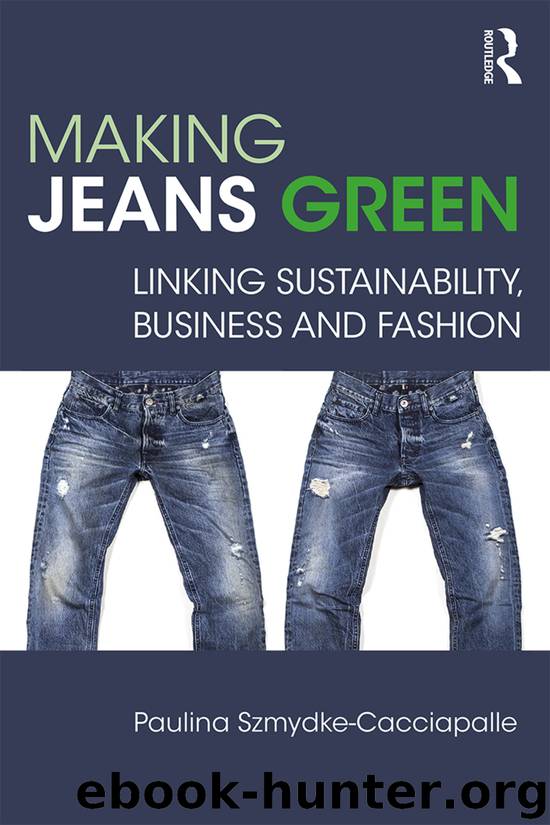Making Jeans Green by Paulina Szmydke-Cacciapalle

Author:Paulina Szmydke-Cacciapalle
Language: eng
Format: epub
Publisher: Routledge
FIGURE 4.4 Indigo powder vs. pre-reduced indigo
Source: Dystar
Natural indigo
Fabrics can, of course, still be dyed the old-school way, leaving synthetic chemicals entirely out of the equation. Natural indigo is available, albeit in much smaller amounts, which is why it is a better fit for fashion brands that have “small is beautiful” written into their manifesto. Almost every region in the world has its own variety of indigo plants, even Europe, where woad was particularly popular in the Middle Ages. With natural indigo, natural fermentation is key. Some mills tend to use natural indigo and advertise it as such, but mix the base with chemical reducing agents to speed up the process. Fermentation, on the other hand, is a recipe handed down from generation to generation. In places like India or Japan, every artisan has their own way of working with local, organic ingredients. Indigo masters in Okinawa, for instance, use sugar, Japanese sake and lime.
Denim connoisseurs swear by natural indigo, which gives the fabric a brighter, more brilliant color.
While it is true that additional land is needed to cultivate natural indigo, in India, where farmers grow indigo in their backyard or use it as a rotation crop, indigo plants grow very fast; this makes them economically viable, and they produce excellent high-purity indigo. Unlike woad in Europe, which is considered a hungry crop in need of nitrogen and can starve soil with time, Indigofera in India, of which there are roughly 700 species, can fix its own nitrogen from the atmosphere.
Natural indigo’s main problem is the high water consumption, as it takes large baths to ferment the leaves. However, the water can be recycled. Colors of Nature, which was chosen as a fellow in the Levi’s Collaboratory, a project that scouts more sustainable practices, is famed for having used the same dyeing water since 1993. The company’s founder, Jesus Ciriza Larraona, is currently looking to up-scale the fermentation process to industrial levels. He says it’s a method that can be used by both craftsmen and industries.12
The company currently operates with 40 vats, which equals 19,000 liters of indigo dye solution. Those vats can dye up to 30 kilograms of material per day, depending on the depth of colors desired. The company explains:
We get our indigo cakes from a village only 60 kilometres from Auroville, which happens to be a world leader in natural indigo supply. There, indigo is extracted from Indigofera tinctoria leaves. On our site we grind the cakes, then add the powder to our vats. Since we wash using only biodegradable soap and have a water treatment system, all the water is re‐used for our gardens. Once we start to cultivate indigo in [our] own field, we’ll close the loop completely.13
The company’s aim is to increase daily capacity to 1,000 kg. As the dyers note: “We also want to expand indigo cultivation on Auroville lands. This dye‐yielding plant can revive barren land and provide income to rural women gatherers. Its’ only by‐product? Compost.”
A similar revival project was funded
Download
This site does not store any files on its server. We only index and link to content provided by other sites. Please contact the content providers to delete copyright contents if any and email us, we'll remove relevant links or contents immediately.
| Advertising | Annuals |
| Book Design | Branding & Logo Design |
| Fashion Design | Illustration |
| Science Illustration |
Wonder by R.J. Palacio(7723)
Unlabel: Selling You Without Selling Out by Marc Ecko(2975)
POP by Steven Heller(2878)
Hidden Persuasion: 33 psychological influence techniques in advertising by Marc Andrews & Matthijs van Leeuwen & Rick van Baaren(2771)
The Pixar Touch by David A. Price(2736)
Ogilvy on Advertising by David Ogilvy(2677)
Drawing Cutting Edge Anatomy by Christopher Hart(2671)
Slugfest by Reed Tucker(2412)
The Art of War Visualized by Jessica Hagy(2408)
The Curated Closet by Anuschka Rees(2378)
Stacked Decks by The Rotenberg Collection(2266)
The Wardrobe Wakeup by Lois Joy Johnson(2228)
365 Days of Wonder by R.J. Palacio(2227)
The Code Book by Simon Singh(2202)
Rapid Viz: A New Method for the Rapid Visualization of Ideas by Kurt Hanks & Larry Belliston(2189)
Tell Me More by Kelly Corrigan(2189)
Keep Going by Austin Kleon(2154)
Tattoo Art by Doralba Picerno(2079)
Tokyo Geek's Guide: Manga, Anime, Gaming, Cosplay, Toys, Idols & More - The Ultimate Guide to Japan's Otaku Culture by Simone Gianni(1941)
